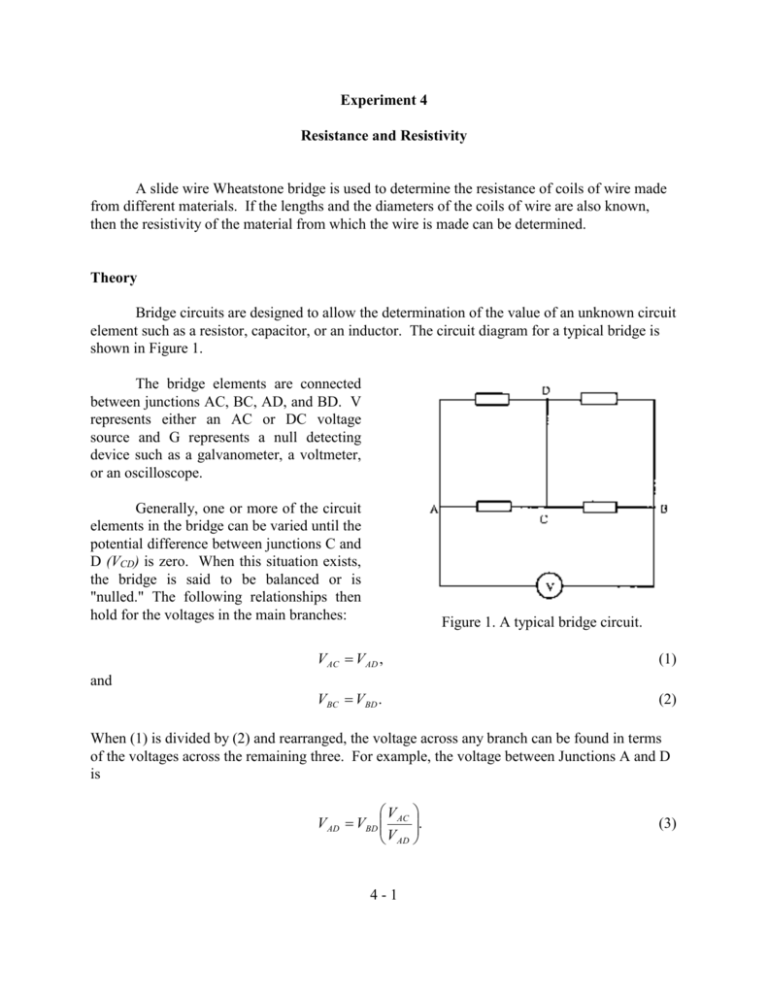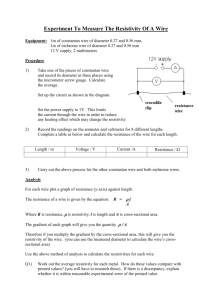Experiment 4
advertisement

Experiment 4 Resistance and Resistivity A slide wire Wheatstone bridge is used to determine the resistance of coils of wire made from different materials. If the lengths and the diameters of the coils of wire are also known, then the resistivity of the material from which the wire is made can be determined. Theory Bridge circuits are designed to allow the determination of the value of an unknown circuit element such as a resistor, capacitor, or an inductor. The circuit diagram for a typical bridge is shown in Figure 1. The bridge elements are connected between junctions AC, BC, AD, and BD. V represents either an AC or DC voltage source and G represents a null detecting device such as a galvanometer, a voltmeter, or an oscilloscope. Generally, one or more of the circuit elements in the bridge can be varied until the potential difference between junctions C and D (VCD) is zero. When this situation exists, the bridge is said to be balanced or is "nulled." The following relationships then hold for the voltages in the main branches: Figure 1. A typical bridge circuit. V AC V AD , (1) VBC VBD . (2) and When (1) is divided by (2) and rearranged, the voltage across any branch can be found in terms of the voltages across the remaining three. For example, the voltage between Junctions A and D is V V AD VBD AC . V AD 4-1 (3) The Wheatstone bridge is shown schematically 'n Figure 2. The coils of wire whose resistance is to be, determined is connected between junctions A and D, and a known value of resistance is connected between B and D. A potentiometer is connected between A and B with a tap at point C. The position of the tap can be altered by adjusting the dial on the potentiometer and, thereby, changing the resistances, R AC and R BC, on either side of point C. These changes then vary the voltage V AC and V BC. Figure 2. Schematic of the Wheatstone bridge. When the bridge is in the null condition (3) holds and a current I, flows from A to D to B, and a current I2 flows from A to C to B. Knowing that the voltage across a resistor is IR (Ohm's Law), equation (3) can be expressed as RAC . R BC R AD R BD (4) The value of RAC is the reading on the potentiometerdial, R, and the value of R BC is 10 - R. Equation (4) can now be written as R AD RBD R . 10 R (5) This is the working equation for the Wheatstone bridge. The resistivity of the coil of wire with resistance RAD can now be determined. For a wire with a uniform cross-sectional area, the resistance is 4-2 R AD LAD A . When this expression is rearranged, ARAD , L AD (6) where p is the resistivity, L,4Dis the length of the coil of wire, and A is its cross-sectional area. When the cross-sectional area is expressed in terms of its diameter, d, the expression for its resistivity Is d 2 R AD 4 L AD . (7) Apparatus o potentiometer o DC power supply o galvanometer o standard resistance box, ±0.2% o coil of copper wire o coil of German silver wire o coil of Nichrome wire o 5 leads Procedure 1) Connect the Wheatstone bridge circuit with the standard resistance box between junctions B and D and the coil of copper wire of unknown resistance between junctions A and D. Record the gauge number of the wire coil and its length. 2) Turn on the DC power supply and adjust the voltage knob for some intermediate value. 3) Set the dial on the potentiometer to the 5.00 reading. 4) Depress KEY 1, 5 VOLTS button on the galvanometer. Pull and replace the plugs on the resistance box until the galvanometer needle is zeroed or nearly zeroed. Now depress KEY 2, 0.1 VOLTS button and again pull and replace the plugs until the needle is zeroed or nearly zeroed. Finally, depress the most sensitive button (KEY 3GALV) and again attempt to zero the reading by adjusting the resistance box. CAUTION: If the most sensitive button (KEY 3-GALV) is depressed first, too much current may flow through the galvanometer causing it to bum out. 4-3 5) Hold the most sensitive button (KEY 3-GALV) depressed and turn the dial on the potentiometer until the galvanometer is zeroed. If uncertainties are, to be calculated, then find the range of values of R that will zero t-he galvanometer. Record these values as Rmin and Rmax. 6) Repeat steps (1) through (5) using the coil of German (nickel) silver wire. Repeat again with the Nichrome (Chromel) wire. Analysis Use (5) and (7) to determine the resistivity of copper, German silver, and Nichrome. If uncertainties are to be calculated, then the value of R in (5) is expressed as R ( Rmin Rmax ) , 2 R ( Rmax Rmin ) . 2 and An estimate of the reliability of the resistivity values can be found using the "worst case' method of analysis. The uncertainty is the resistivity is R R R(10 R) BD , R (10 R) RBD (8) where the uncertainty in the diameter and length of the wire on the coil is neglected. In (8), AR = R (10 R) and RBD / RBD 0.002. (Note that the standard resistance box has a tolerance of ±0.2%. If a different resistance box is used, then the fractional uncertainty of the resistance will be different.) In a table, report the experimental values of the resistivity for the three materials, their uncertainties (if calculated), the book values of the resistivities, and percentage errors when appropriate. Conclusions Explain what factor(s) caused the greatest errors in your determination of the resistivity, and why. Do your results seem to indicate the presence of these sources of error? 4-4 Questions 1. On what microscopic process does the resistivity depend? 2. Does the resistivity of a conductor increase, decrease, or remain the same when the temperature of the conductor increases? Explain. What about a semiconductor? Why? 3. Start with (7) and derive (8). 4. The last two terms inside the brackets in (8) give a measure of the fractional uncertainty associated with the potentiometer. Suppose that the uncertainty in the potentiometer reading is ±0.05 cm. If the reading, R, is 1.00, then what 's the total fractional uncertainty of the last two terms in the brackets? If the slide wire reading is 5.00, then what is the total fractional uncertainty? Does this provide a clue as to why the potentiometer reading, RL, should be as close as possible to the 5.00 position? 4-5








